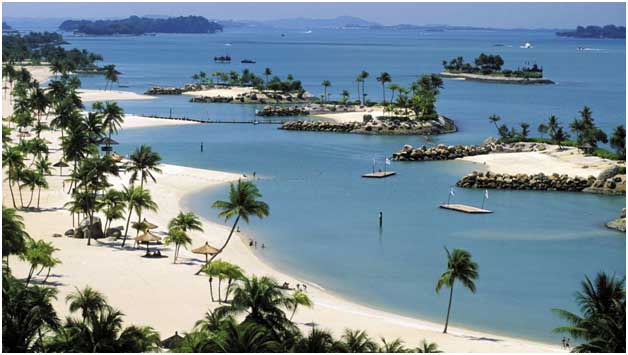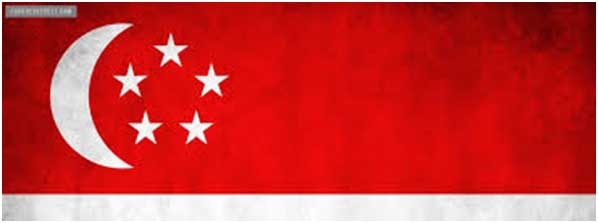The Ultimate Singapore Travelers Guide
Singapore Travelers Guide
Singapore: A Corporate and Financial Giant
Singapore Travelers Guide - despite its small size, stands as a corporate and financial powerhouse. It has been Southeast Asia's most successful city for over a century. The city seamlessly blends Malay, Chinese, Arab, Indian, and English cultures and religions. This ethnic diversity offers visitors a wide array of sightseeing and culinary options. The calendar is always bustling with business conventions, expos, celebrations, and holidays. With so many events throughout the year, there's never a dull moment in Singapore.
Diverse Cultural Experiences
Singapore provides a variety of cultural experiences that cater to all tastes. Extravagant hotels, delectable cuisine, and fantastic shopping opportunities abound. The island nation, lying just one degree north of the Equator in Southern Asia, spans a land mass of only 687 km². The Republic of Singapore comprises the main island and approximately 58 smaller islands. Despite its compact size, the government has transformed Singapore into a thriving nation excelling in numerous areas.
Efficient Infrastructure and Tourism
Tourism is exceptionally well catered for, and many countries aspire to replicate Singapore's impressive infrastructure. The capital city, also named Singapore, covers about one-third of the total island. Located at the tip of the Malay Peninsula, Singapore's tropical climate welcomes both leisure and business travelers year-round. The island republic's excellent infrastructure enables visitors to enjoy its many attractions in a safe, clean, and green environment.
Award-Winning Connectivity
Award-winning Changi Airport provides air links to major cities worldwide. The train and tram systems are clean, fast, and efficient, ensuring convenient travel across the city. Singapore's ferry terminal establishes it as a leading water cruising nation in Southeast Asia, serving as a busy and capable port for any Asian voyage or vessel. The public transportation system eliminates the need for an automobile, making it easy to explore the city on foot or by public transport.
Tropical Climate and Accessibility
Singapore's tropical climate remains consistent, with temperatures close to the equator and little variation year-round. Precipitation is evenly distributed, so there is no significant wet season. Regardless of when you visit, warm weather will be a constant companion. Major attractions are easily accessible via public transportation, making it convenient for tourists to explore the city. The city's layout and infrastructure make it an ideal destination for both short and long stays.
Natural Beauty and Green Spaces
Visitors are immediately struck by Singapore's abundance of parks, nature reserves, and lush, tropical greenery. The city is a green haven amidst urban development, with numerous green spaces providing a refreshing escape. Gardens by the Bay, the Singapore Botanic Gardens, and various nature parks offer tranquil spots to relax and enjoy the natural beauty. These green spaces are meticulously maintained, reflecting the government's commitment to environmental conservation.
Cultural Hotspots and Attractions
Singapore's cultural hotspots are a testament to its rich heritage. Chinatown, Little India, and Kampong Glam showcase the diverse cultural fabric of the city. Each district offers unique experiences, from traditional temples and bustling markets to exquisite cuisine and vibrant festivals. The Marina Bay Sands, with its iconic rooftop pool and observation deck, provides stunning views of the city skyline. The Esplanade, known for its unique architecture, hosts a variety of cultural performances and events.
Shopping and Dining Experiences
The shopping and dining experiences in Singapore are unparalleled. Orchard Road, a shopper's paradise, features high-end boutiques, department stores, and a variety of dining options. Hawker centers like Maxwell Food Centre and Lau Pa Sat offer a taste of local cuisine in a lively, authentic setting. The city’s diverse food scene includes everything from street food to fine dining, catering to all tastes and budgets. Culinary delights reflect the multicultural influences that shape Singapore's identity.
Business and Innovation
Singapore's status as a global business hub is supported by its robust economy and innovative spirit. The city attracts multinational corporations and fosters a thriving startup ecosystem. Business travelers find a conducive environment for networking, conferences, and corporate events. State-of-the-art facilities and services ensure a seamless experience for professionals. The city’s commitment to innovation is evident in its smart city initiatives and technological advancements.

Singapore's Remarkable Advancement
Singapore's advancement over recent decades has been noteworthy, yet the island has not been overwhelmed by development. Visitors will find a wealth of historical treasures, showcasing the beauty of older structures and traditions. These qualities persist despite significant social and geographical changes. The city has managed to blend modernity with heritage, creating a unique environment where the past and present coexist harmoniously. This balance makes Singapore an intriguing destination for travelers.
Path to Prosperity
Singapore's road to prosperity began with an agreement that allowed commerce to flourish unhindered by government formalities. Established in 1819 by Sir Stamford Raffles, the British Ambassador, this policy laid the foundation for economic growth. Mass industrialization later boosted the economy, and today the state boasts the world's second-busiest port after Rotterdam. The country experiences minimal unemployment and has a highly educated and professional populace. Nearly the entire population lives in upscale apartments, with an average wage exceeding $5000 USD per month.
Clean and Safe Environment
Singapore is a clean, safe place to visit, with amenities that are second to none. Public areas are smoke-free and hygienic, contributing to the city's reputation for cleanliness. Visitors can enjoy a secure environment while exploring the city's attractions. The commitment to maintaining high standards of cleanliness and safety enhances the overall experience for tourists and residents alike.
Singapore Travelers Guide
Framing the core of downtown Singapore is the Colonial District. Each nook and cranny of this area has its own distinctive flavor. The fragrant spice stores of Little India offer a sensory delight, while the backstreets of Chinatown still house traditional calligraphers and psychics. The Arab Quarter features jumbled stores selling fine fabrics, silks, and unique knick-knacks. These diverse neighborhoods provide a rich tapestry of cultural experiences.
Colonial District Charm
The Colonial District is home to many of Singapore's historical landmarks. Visitors can explore the grandeur of buildings like the Raffles Hotel and the Victoria Theatre and Concert Hall. This area showcases the architectural beauty of Singapore's colonial past. The well-preserved structures and lush green spaces create a charming atmosphere that contrasts with the bustling modern cityscape. Walking through this district offers a glimpse into Singapore's historical journey.
Little India and Chinatown
Little India captivates visitors with its vibrant colors, aromas, and bustling markets. The district is a hub for Indian culture, featuring temples, eateries, and shops selling traditional goods. Chinatown, on the other hand, offers a mix of old and new, with heritage shophouses standing alongside modern developments. This area is known for its delicious street food, cultural festivals, and historic temples. Both districts provide unique insights into the multicultural fabric of Singapore.
Arab Quarter and Its Allure
The Arab Quarter, also known as Kampong Glam, is renowned for its rich history and vibrant culture. This area is a treasure trove of fine fabrics, silks, and artisanal crafts. The streets are lined with charming shops and cafes, making it a popular spot for both locals and tourists. The majestic Sultan Mosque stands at the heart of the quarter, serving as a symbol of the area's cultural significance. Exploring the Arab Quarter offers a unique cultural immersion.
Modern Marvels and Heritage Sites
Singapore's cityscape is a blend of modern marvels and heritage sites. Iconic structures like Marina Bay Sands and the Esplanade coexist with historic buildings and temples. This juxtaposition creates a skyline that tells the story of the city's development. Visitors can appreciate the meticulous planning and design that have shaped Singapore into a world-class city. The combination of cutting-edge architecture and well-preserved heritage sites adds to the city's allure.

Singapore Flag
The Symbolism of the Singapore Flag
The Singapore national flag features two distinct colors: red and white. Red symbolizes fraternity and equality, reflecting the nation's commitment to unity and harmony. White represents purity and virtue, highlighting the country's dedication to integrity and moral values. Together, these colors convey Singapore's core principles and aspirations.
The Crescent Moon and Its Significance
A prominent feature of the flag is the crescent moon. This symbol represents a young nation on the rise, embodying growth and progress. The crescent's upward curve signifies Singapore's continuous development and forward momentum. It reflects the country's dynamic spirit and ambition to achieve greater heights.
The Five Stars and Their Meanings
Five white stars accompany the crescent moon, each holding significant meaning. These stars symbolize Singapore's ideals of democracy, peace, progress, justice, and equality. Democracy emphasizes the importance of citizen participation in governance. Peace highlights the nation's commitment to harmony and stability, both internally and externally. Progress underscores the continuous pursuit of development and innovation. Justice represents fairness and the rule of law, ensuring equal rights for all. Equality reflects the belief in equal opportunities and treatment for every individual, regardless of background.
Origins of the Singapore Flag
The Singapore flag was conceived when Singapore gained self-governance in 1959. It was designed by a committee led by then Deputy Prime Minister Dr. Toh Chin Chye. The design aimed to encapsulate the values and aspirations of the newly formed nation. The flag was officially adopted on December 3, 1959, symbolizing the country's newfound identity and independence.
Historical Context and Adoption
Before its adoption, Singapore's flag underwent rigorous scrutiny to ensure it accurately represented the nation's spirit. The design process involved multiple revisions and consultations. Upon finalization, the flag was presented to the public and received widespread acceptance. Its unveiling marked a significant moment in Singapore's history, representing unity and collective identity.
Significance in Modern Times
Today, the Singapore flag continues to hold deep significance for its citizens. It is prominently displayed during national celebrations and important events. The flag serves as a reminder of the nation's journey and the values that bind its people. Its symbolism fosters a sense of pride and belonging among Singaporeans.
Usage and Etiquette
There are specific guidelines regarding the proper use and display of the Singapore flag. These rules ensure the flag is treated with respect and dignity. It is often flown during National Day, public holidays, and official functions. The flag's presence in everyday life reinforces the shared values and unity of the nation.
Educational Importance
Schools in Singapore emphasize the importance of understanding the national flag's symbolism. Students learn about the flag's history, design, and meanings through the curriculum. This education fosters national pride and a deeper appreciation for the country's heritage. By understanding the flag's significance, young Singaporeans develop a sense of responsibility towards upholding the nation's values.

The crescent moon originally served as a symbol of assurance to the Malays in 1959 —the year the flag was designed— that Singapore was not a Chinese state. Today it is generally said that the moon signified a young nation rising. The flag was designed initially to have three stars, until leaders such as then Deputy Prime Minister Toh Chin Chye expressed concern that Singapore might be perceived to have associations with the Malayan Communist Party, the flag of which also had three stars. The flag was originally meant to be red as red is a very traditional Chinese color. But because of the fear of Communism in those days, a completely red flag was abandoned.
Singapore Cultural Events And Public Holiday Guide
Most Singaporeans are multi lingual speaking people with their ancestry coming from many different Countries of origin, religions and heritage. As such Singapore boasts a large number of Singapore's polyglot population celebrates a number of festivals,
Read MoreA Guide To Singapore Weather And Geography
Uncover Singapore Weather and Geography and the bustling CBD, a lively cultural areas, and breath-taking night scenes. Enjoy shopping, dining, and endless entertainment.
Read More


